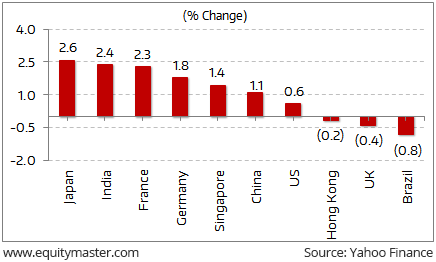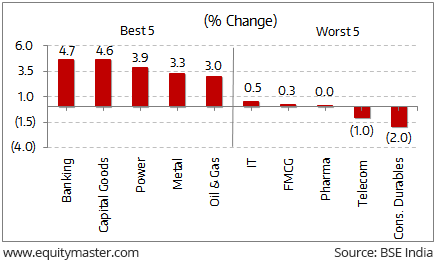Global markets continued to remain buoyant in the week gone by. The US markets ended higher by 0.6% on the back of a tech rally fueled by strong quarterly performance by IT heavyweights such as Amazon, Microsoft, Alphabet and Intel.
Even the U.S. dollar rallied backed by a brightening outlook for tax cuts, better-than-expected third quarter GDP data and a dovish take on actions by the European Central Bank. The central bank said it would halve its asset purchase program to €30 billion a month, but also extend it for at least nine months until September 2018.
With the European Central Bank extending its stimulus package, both France and German indices yielded returns of 2.3% and 1.8%, respectively. But the UK market was marginally down by 0.4% in the week gone by.
A majority of the Asian markets ended on a firm footing on positive global cues. The Japanese market was the biggest gainer, up 2.6% in the week gone by. Japan’s Nikkei hit a 21-year high led by bank and tech stocks. The Indian indices were the second best performing after Nikkei. The BSE Sensex breached the 33,000 mark after the government’s big-ticket announcements to recapitalize state-run banks and invest in the road infrastructure revitalized the markets. The Chinese market was up by 1.1% for the week that saw President Xi Jinping consolidate power at a key Party Congress, pledging to build a modern social country for a “new era”.
Key World Markets During the Week

Back home, the spectacular stock market gains were powered by banks, particularly state-run, that rallied the most after the government’s Rs 2.11 trillion recapitalization infused fresh hopes of resolving the bad loan mess. A majority of the sector indices ended the week on a positive note. Stocks from the capital goods and power sectors were among the major gainers during the week.
BSE Indices During the Week

Now let us discuss some key economic and industry developments during the week gone by.
The biggest economic development in the week was the mega package unveiled by the government to resolve the bad loan mess and stimulate road infrastructure in the country. The finance ministry announced a Rs 2.11 trillion bank recapitalization plan for state-owned lenders weighed down by bad loans, seeking to stimulate the flow of credit to spur private investment. Out of the total commitment, Rs 1.35 trillion will come from the sale of so-called recapitalisation bonds. The remaining Rs 760 billion will be through budgetary allocation and fundraising from the markets.
The bank recapitalization package marks a sharp increase over the current budgetary allocation. Under the Indradhanush plan, the government has allocated Rs 200 billion towards bank recapitalization over the current and next fiscal years. This is part of a broad plan to create thousands of new jobs, raise income, boost investment and quicken growth in the broader economy.
Note that Indian banks are sitting on a stressed asset pile of close to Rs 10 trillion, crimping their ability to give fresh loans; of this, gross non-performing assets (NPAs) account for Rs 7.7 trillion and the rest are restructured loans.
Considering the government’s current fiscal position and the huge bank recapitalization requirement, this method of capital infusion is possibly the best option because not all PSU banks are in a position to tap markets given the asset quality issue, the reports noted.
The government also approved mega infrastructure projects worth Rs 6.92 trillion as part of a broad plan to create thousands of new jobs, raise income, boost investment and quicken growth in the broader economy.
Finance minister Arun Jaitley said that the government will launch an umbrella road building program to de-bottleneck the sector. The program will cover 83,677 km of roads and will involve a capital expenditure of Rs 6.92 trillion over the next 5 years.











Leave A Comment